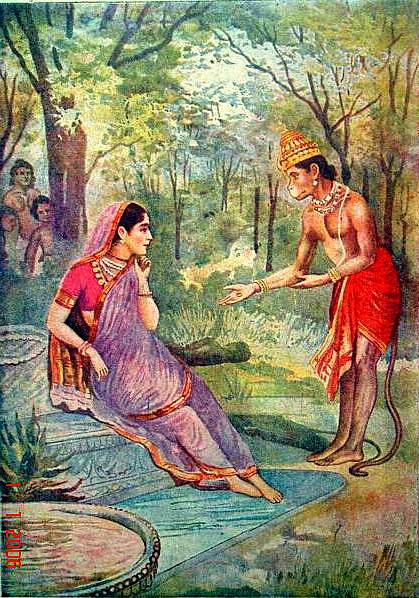Sundara Kanda
Sundara Kanda (the book of the beautiful) is the fifth book of the Valmiki Ramayana, which is one of the two great epics of India (the other being the Mahabharata).
The book consists of 68 sargas (sometimes translated as chapters or "cantos") of Sanskrit verse.
Sundara Kanda is the only Book of the Ramayana in which the hero is not Rama, but rather Hanuman. The work depicts the adventures of Hanuman and his selflessness, strength, and devotion to Rama are emphasized in the text. Hanuman was fondly called “Sundara” by his mother Anjani and Sage Valmiki chose this name over others as the Sundara Kanda is about Hanuman's journey to Lanka.
The Sundara Kanda forms the heart of Valmiki's Ramayana and consists of a detailed, vivid account of Hanuman's adventures. After learning about Sita, Hanuman assumes a gargantuan form and makes a colossal leap across the ocean to Lanka after defeating Surasa, the Mother of the Nagas and Sinhika, who is sent by the Asuras.
Here, Hanuman explores the demon's city and spies on Ravana. He locates Sita in the Ashok Vatika, who is wooed and threatened by Ravana and his demon mistresses to marry Ravana. He reassures her, giving Rama's signet ring as a sign of good faith. He offers to carry Sita back to Rama, however she refuses, reluctant to allow herself to be rescued by any one, other than her husband. She says that Rama himself must come and avenge the insult of her abduction.
Hanuman then wreaks havoc in Lanka by destroying trees and buildings, and killing Ravana's warriors. He allows himself to be captured and produced before Ravana. He gives a bold lecture to Ravana to release Sita. He is condemned and his tail is set on fire, but he escapes his bonds and, leaping from roof to roof, sets fire to Ravana's citadel and makes the giant leap back from the island. The joyous search party returns to Kishkindha with the news.
The act of reading
It is traditional to begin the reading (pārāyaṇa) of the Ramayana with the Sundara Kanda.
This lesson is recited by religious Hindus, preferably on Tuesdays or Saturdays, these days having been earmarked for special prayers to Hanuman. It happens to be for nullification of the malefic effects of the crow mounted, the son of Surya and Chhaya (Shadow), Lord Shani. Ramayana reveals that Shani Dev, who was captive at Ravana's palace, was rescued by Lord Hanuman. As a token of thanks, Shani Dev offered reprieve to all devotees of Lord Hanuman. Alternately once Shani Dev was caught between Hanuman's shoulders and the ceiling when attempting to mount the latter to influence his stars. Unable to bear the pain, Shani Dev offered gratitude in return to an immediate release.
The religious faith suggests that its recital brings harmony to the household. Many Hindus believe that if one does not have time to read the whole Ramayana, one should read the Sundara Kanda.
Click on the link below for the Kannada translation of Sundara Kanda of Valmiki Ramayana by N Ranganatha Sharma, with original Sanskrit Shlokas:
Click on the link below for the original Sanskrit Shlokas (in Kannada script) of Sundara Kanda of Valmiki Ramayana:
Click on the link below for the Sundara Kanda of Valmiki Ramayana in Sanskrit, as per the Baroda Critical Edition:
Click on the links below for translations of Sundara Kanda of Valmiki Ramayana:
- Sundara Kanda in English by Griffith
- Sundara Kanda in English by MN Dutt
- Sundara Kanda in English by Hari Prasad Sastry
